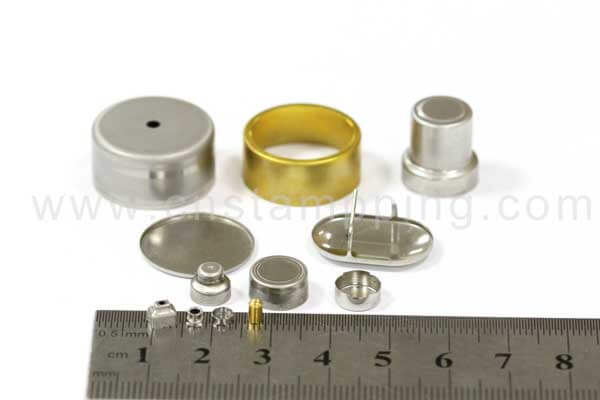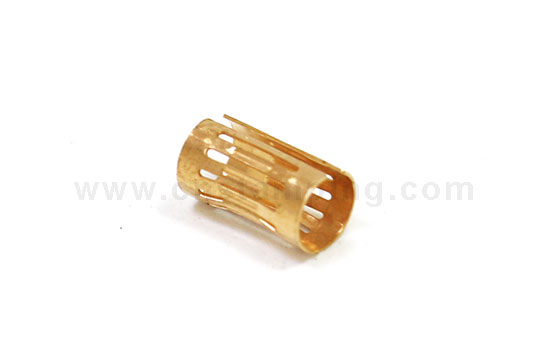Difference Between Sheet Metal Stamping & Deep Drawing Stamping (2)
What is Deep Drawing Stamping?
Deep drawing stamping is a manufacturing process that uses a mold to stretch a material into its final shape by forcing a sheet of metal into the mold. The main benefit is that it can create complex shapes quickly and efficiently. If you need metal parts with lots of curves or intricate details, this type of stamping may be an ideal choice. Because it can be adapted to almost any design constraints, and deep drawn parts are more durable than stamped parts as they are subject to slight wear during production.

Advantages of Deep Drawing Stamping
Mass Production
Deep drawing can quickly and efficiently produce large quantities of high quality parts. This makes it an attractive option for businesses that need to create many products in a short amount of time.
Easy-to-use
The relative simplicity of the deep drawing process makes it an ideal choice for businesses looking to save on labor costs. This type of stamping does not require as much expertise as some other methods, so your staff can learn how to operate the machine relatively easily.
Adapt to Complex Designs
As mentioned before, deep drawing can easily create complex parts without design constraints. This makes it a great option for businesses that need unique or custom metal parts without paying extra fee for a design.
Flexibility
The benefit of deep drawing is the ability to use a wide variety of material types. This can be especially beneficial if you are trying to reduce costs or improve product quality by switching from one metal type to another.
Industry Versatility
If you need help with a mechanical problem, or need more information about this manufacturing process, you can have access to more experts to assist you with your work, as deep drawing is used in many industries.

Disadvantages of Deep Drawing Stamping
Risk of High Scrap Rates
Deep drawing can result in high scrap rates if the wrong material is used. Or if the metal is not adequately prepared before fabrication begins. For deep drawing to be successful, the metal needs to be free of any scratches, bumps or other surface irregularities. If the part contains any defects, it will need to be scrapped and replaced with a new part.
High Cost
Due to the complexity of the deep drawing process, dies and tooling are more expensive than those used for sheet metal stamping. This can make it a challenge to produce high-quality parts at a reasonable cost.
Poor Life
Deep draw stamping reduces the life of the parts because they are not as durable as sheet metal stamped parts made using other manufacturing methods such as bend forming. Deep-drawn parts are prone to surface deformation and bending because they are subjected to constant tension during the deep-draw stamping process. This requires careful inspection of every part after production, which adds extra labor costs to the overall manufacturing budget.
High-end Factories
Deep draw stamping requires specialized equipment and is usually used only in factories with high-end machines. So, If you switch from sheet metal stamping to deep draw stamping, you may need to invest in new or upgraded equipment, which may be cost prohibitive for some businesses.
Longer Production Times
Compared to other manufacturing processes such as injection molding and thermoforming, deep drawing stamping requires more steps and time. This can make it challenging to remain competitive while meeting tight deadlines or production quotas.
What is the Difference Between Sheet Metal Stamping and Deep Drawing Stamping?
Cost
The main difference between sheet metal stamping and deep drawing stamping is cost. Sheet metal stamping costs is less than deep drawing stamping, as it requires more tooling and setup time. This also makes it an economical option for businesses that need to produce large quantities of parts quickly.
Durability
Parts produced by sheet metal stamping are more durable than parts made by deep drawing processes. This is because the material is not subjected to as much tension during production, reducing the possibility of surface deformation or bending.
Easy-to-use
Compared to deep drawing stamping, sheet metal stamping is a simple process that does not require as much highly skilled labor to operate the machine. This makes it a good option for businesses looking to save on labor costs.
Shape and size
Sheet metal stamping is limited to simple designs, while deep draw stamping can produce parts of considerable complexity, detail and/or size, as long as the size fits the machine’s capabilities.
Tolerance
The tolerances of deep drawing stamping are not as precise as those achieved by sheet metal stamping. This means greater dimensional variation in deep-drawn parts, which can be a problem for businesses that require parts with tight tolerances. At the same time, there are higher requirements for technology.
Material Type
Deep drawing works best with metal plates, making them a good choice for industries that work primarily with metal. But Sheet metal stamping can make parts from any material, expanding its appeal in all fields.
Should You Prefer Sheet Metal Stamping to Deep Drawing?
The choice to use sheet metal stamping or deep drawing stamping depends on the specific needs of your business. Deep draw stamping is better if you need parts with high tolerances, durability and shape. However, if you need many parts quickly and cheaply, then sheet metal stamping is the better choice.
Conclusion
Sheet metal stamping and deep drawing stamping are both feasible methods for manufacturing hardware parts. Your choice should be based on the specific needs of your business. If you need high quality, durable parts with complex shapes, deep draw stamping is the better choice. Sheet metal stamping is a better choice if you need many features fast and low cost.
